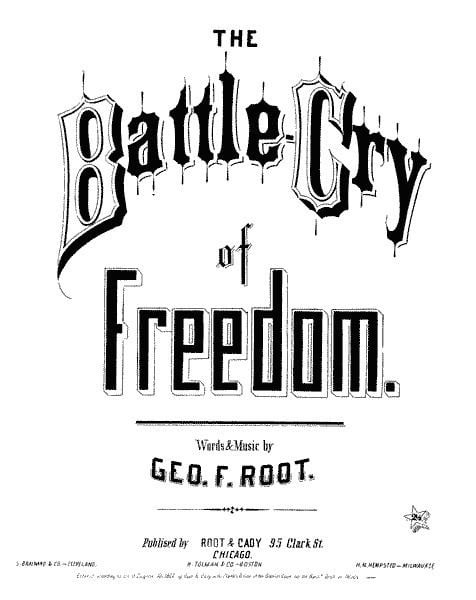 | ||
The "Battle Cry of Freedom", also known as "Rally 'Round the Flag", is a song written in 1862 by American composer George Frederick Root (1820–1895) during the American Civil War. A patriotic song advocating the causes of Unionism and abolitionism, it became so popular that composer H. L. Schreiner and lyricist W. H. Barnes adapted it for the Confederacy.
Contents
- History
- Lyrics Union version
- Lyrics Confederate version
- Chorus 1864 election campaign
- In popular culture
- References
A modified Union version was used as the campaign song for the Lincoln-Johnson ticket in the 1864 presidential election, as well as in elections after the war, such as for Garfield in the 1880 U.S. presidential election. The song was so popular that the music publisher had 14 printing presses going at one time and still could not keep up with demand. It is estimated that over 700,000 copies of this song were put in circulation. Louis Moreau Gottschalk thought so highly of the song that in his diary he confided that he thought "it should be our national anthem" and used it as the basis for his 1863 concert paraphrase for solo piano "Le Cri de délivrance," opus 55, and dedicated it to Root, who was a personal friend. Charles Ives quoted the song in his own patriotic song, "They Are There".
History
"Battle Cry of Freedom" proved popular among Union soldiers during the American Civil War. According to Henry Stone, a Union war veteran recalling in the late 1880s, the song helped the morale of Union soldiers:
A glee club came down from Chicago, bringing with them the new song, "We'll rally 'round the flag, boys", and it ran through the camp like wildfire. The effect was little short of miraculous. It put as much spirit and cheer into the army as a victory. Day and night one could hear it by every camp fire and in every tent. I never shall forget how the men rolled out the line, "And although he may be poor, he shall never be a slave." I do not know whether Mr. Root knows what good work his song did for us there, but I hope so.
According to historian Christian L. McWhirter, the song's success and popularity among the Union was due to its even-handed references to both abolitionism and unionism. Thus, both groups of Unionists, those opposed to slavery and secession, could utilize the song without reservation:
The ability of "The Battle Cry of Freedom" to bridge divisions over emancipation is not surprising. The song's definition of the Northern cause is purposely open-ended. Those looking for anti-slavery sentiments could find them, but these elements were not so pronounced as to offend those who were solely unionists. The chorus was the key, for it was there that Root described why Northerners rallied around the flag. The first line boldly endorsed a perpetual Union – "The Union forever" – followed by a strong dismissal of secession: "Down with the traitor, up with the star." However, the battle cry Root shouted was one of "freedom." Freedom had many meanings in the Civil War – for instance, freedom from Confederate political tyranny or the oft-perceived "slaveholders' conspiracy" – but, in the context of Root’s political beliefs and other activities, he clearly meant to suggest some degree of abolitionism.
Lyrics (Union version)
Yes we'll rally round the flag, boys, we'll rally once again,
Shouting the battle cry of freedom,
We will rally from the hillside, we'll gather from the plain,
Shouting the battle cry of freedom!
We are springing to the call for three hundred thousand more,
Shouting the battle cry of freedom!
And we'll fill the vacant ranks of our brothers gone before,
Shouting the battle cry of freedom!
We will welcome to our numbers the loyal, true and brave,
Shouting the battle cry of freedom!
And although he may be poor, he shall never be a slave.,
Shouting the battle cry of freedom!
So we're springing to the call from the East and from the West,
Shouting the battle cry of Freedom;
And we'll hurl the rebel crew from the land we love the best,
Shouting the battle cry of Freedom.
Lyrics (Confederate version)
Our flag is proudly floating on the land and on the main,
Shout, shout the battle cry of Freedom!
Beneath it oft we've conquered, and we'll conquer oft again!
Shout, shout the battle cry of Freedom!
Our gallant boys have marched to the rolling of the drums.
Shout, shout the battle cry of Freedom!
And the leaders in charge cry out, "Come, boys, come!"
Shout, shout the battle cry of Freedom!
They have laid down their lives on the bloody battle field.
Shout, shout the battle cry of Freedom!
Their motto is resistance – "To the tyrants never yield!"
Shout, shout the battle cry of Freedom!
While our boys have responded and to the fields have gone.
Shout, shout the battle cry of Freedom!
Our noble women also have aided them at home.
Shout, shout the battle cry of Freedom!
